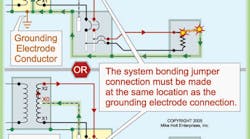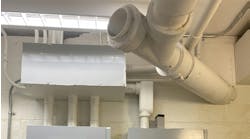A separately derived system is a premises wiring system with no direct electrical connection to conductors originating from another system [Art. 100 definition and 250.20(D)]. All transformers, except autotransformers, are separately derived because the primary circuit conductors do not have any direct electrical connection to the secondary circuit conductors. Generators that supply a transfer switch that opens the grounded neutral conductor would be considered separately derived [250.20(D) FPN 1].
250.30(A) Grounded Systems. Separately derived systems must be system bonded and grounded in accordance with the following:
A neutral-to-case bond must not be on the load side of the system bonding jumper, except as permitted by 250.142(B).
(1) System Bonding Jumper. Bonding the metal parts of the separately derived system to the secondary grounded neutral terminal by the installation of a system bonding jumper ensures that dangerous voltage from a secondary ground fault can be quickly removed by opening the secondary circuit’s overcurrent protection device [250.2(A)(3)].
The system bonding jumper must be sized in accordance with Table 250.66, based on the area of the largest ungrounded secondary conductor [250.28(D)]. The system bonding jumper can be installed at the separately derived system, the first system disconnecting means, or any point in between the separately derived system and the first disconnecting means — but not at both locations.
In addition, the system bonding jumper must be installed at the same location where the grounding electrode conductor terminates to the grounded neutral terminal of the separately derived system, which can be at the separately derived system, the first system disconnecting means, or any point in between — but not at more than one location [250.30(A)(3)].
Exception 2: A system bonding jumper can be installed at both the separately derived system and the secondary system disconnecting means where doing so doesn’t establish a parallel path for neutral current.
For all practical purposes, this isn’t possible except in a wood frame building that doesn’t have any conductive metal.
(2) Equipment Bonding Jumper Size. Where an equipment bonding jumper is run to the secondary system disconnecting means, it must be sized in accordance with Table 250.66, based on the area of the largest ungrounded secondary conductor.
(3) Grounding Electrode Conductor, Single Separately Derived System. Each separately derived system must have the grounded neutral terminal grounded (earthed) to a suitable grounding electrode of a type identified in 250.30(A)(7). The secondary system grounding electrode conductor must be sized in accordance with 250.66, based on the total area of the largest ungrounded secondary conductor. To prevent objectionable current from flowing onto metal parts of electrical equipment, as well as metal piping and structural steel, the grounding electrode conductor must terminate at the same point on the separately derived system where the system bonding jumper is installed.
Exception 1: Where the system bonding jumper [250.30(A)(1)] is a wire or bus bar, the grounding electrode conductor can terminate to the equipment grounding terminal, bar, or bus on the metal enclosure of the separately derived system.
Exception 3: Separately derived systems rated 1kVA or less are not required to be grounded (earthed); however, to ensure ground faults can be cleared, a system bonding jumper must be installed in accordance with 250.30(A)(1).
(4) Grounding Electrode Conductor, Multiple Separately Derived Systems. Where there are multiple separately derived systems, the grounded neutral terminal of each derived system can be grounded (earthed) to a common grounding electrode conductor. The grounding electrode conductor and grounding electrode tap must comply with (a) through (c).
Exception 1: Where the system bonding jumper [250.30(A)(1)] is a wire or bus bar, the grounding electrode tap can terminate to the equipment grounding terminal, bar, or bus on the metal enclosure of the separately derived system.
Exception 2: Separately derived systems rated 1kVA or less are not required to be grounded (earthed); however, to ensure ground faults can be cleared, a system bonding jumper must be installed in accordance with 250.30(A)(1).
(a) Common Grounding Electrode Size. The common grounding electrode conductor must not be smaller than 3/0 AWG copper or 250kcmil aluminum.
(b) Tap Conductor Size. Each grounding electrode tap must be sized in accordance with 250.66, based on the largest separately derived ungrounded conductor of the separately derived system.
(c) Connections. All grounding electrode tap connections must be made at an accessible location by:
- Listed connector
- Listed connections to aluminum or copper bus bars not less than ¼ inch by 2 inch. Where aluminum bus bars are used, the installation must comply with 250.64(A).
- By the exothermic welding process.
Grounding electrode tap conductors must be connected to the common grounding electrode conductor so that the common grounding electrode conductor isn’t spliced.
(5) Installation. The grounding electrode conductor must be installed in accordance with 250.64 and comply with the following:
- Be of copper where within 18 inches of earth [250.64(A)].
- Securely fastened to the surface on which it’s carried [250.64(B)].
- Adequately protected if exposed to physical damage [250.64(B)].
- Metal enclosures enclosing a grounding electrode conductor must be made electrically continuous from the point of attachment to cabinets or equipment to the grounding electrode [250.64(E)].
(6) Bonding. To ensure that dangerous voltage from a ground fault is removed quickly, structural metal and metal piping in the area served by a separately derived system must be bonded to the grounded neutral conductor at the separately derived system in accordance with 250.104(D).
(7) Grounding (Earthing) Electrode. The grounding electrode conductor must terminate to a grounding electrode that is located as close as possible, and preferably in the same area as the system bonding jumper. The grounding electrode must be the nearest of the following: (1) Metal water pipe electrode as specified in 250.52(A)(1). (2) Structural metal electrode as specified in 250.52(A)(2). If neither of these electrodes is available, see other options listed in Exception 1.
(8) Grounded Neutral Conductor. Where the system bonding jumper is installed at the secondary system disconnecting means instead of at the source of the separately derived system, the following requirements apply: (a) Routing and sizing. Because the grounded neutral conductor serves as the effective ground-fault current path, the grounded neutral conductor must be routed with the secondary conductors, and it must be sized not smaller than specified in Table 250.66, based on the largest ungrounded conductor for the separately derived system. (b) Parallel conductors. If the secondary conductors are installed in parallel, the grounded neutral secondary conductor in each raceway or cable must be sized based on the area of the largest ungrounded secondary conductor in the raceway. But the grounded neutral secondary conductor cannot be smaller than 1/0 AWG [310.4].




